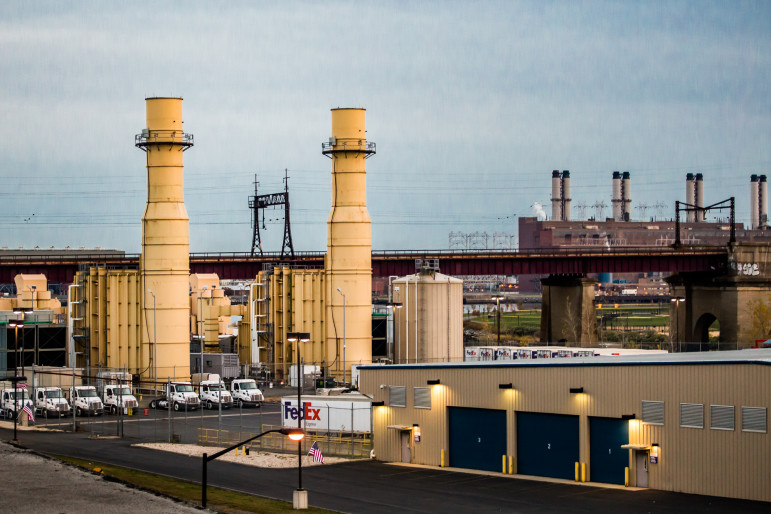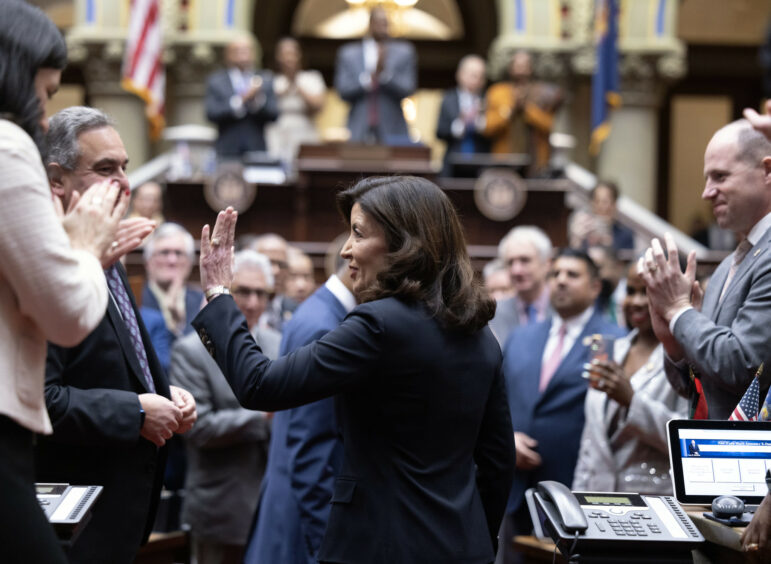The program will charge companies for carbon pollution and introduce a novel rebate initiative that promises to distribute $1 billion to New Yorkers. But environmentalists say its success will rest on how exactly the state designs the program, to ensure it doesn’t allow companies to essentially pay to pollute without meaningfully lowering emissions.

Adi Talwar
Power plants in the South Bronx and Queens.
Last week, Gov. Kathy Hochul released an outline of a Cap-and-Invest program that will put a price on carbon emissions and include a groundbreaking rebate program. It promises to be the first in the country to funnel $1 billion in revenues earned from selling carbon credits into the pockets of locals.
Companies that generate emissions, however, speculate that it will be bad for business and drive up costs for consumers. Meanwhile, environmentalists remain skeptical that the program will deliver on its promise to help New Yorkers bearing the brunt of pollution, especially in marginalized communities.
The Cap-and-Invest program establishes a limit on how much companies can pollute. The cap will get stricter over time until New York’s emissions are brought down by at least 85 percent by 2050, in accordance with the state’s climate law. At last week’s State of the State address, Hochul introduced the program and explained that big emitters will also have to purchase permits to sell polluting fuels.
“The dirtier the fuel – the bigger the price tag,” Hochul said.
Environmental justice groups across the Big Apple welcome the idea of having a Cap-and- Invest program, but worry that if poorly designed, it would end up aiding polluters instead of cutting back on emissions.
Cap-and-Invest initiatives are already in place in California, Washington and Oregon. The fear is that New York will make some of the same mistakes as California, where a Cap-and-Invest program has been around since 2013. The state’s program was heavily criticized for creating loopholes that helped polluters evade caps and essentially pay to pollute.
“We’ve seen this play out in ways that are concerning,” energy attorney Raya Salter told City Limits. Salter is an environmental activist and member of the New York State Climate Action Council, the group that recommended the Cap-and-Invest plan in the first place.
What the price tag will be for polluters who exceed the emissions cap remains to be seen, as details of the plan are yet to be developed. Regardless of how the state sets the price, the business community claims it will impact the market across the board, and in particular, affect companies that generate emissions. That includes fuel and transportation suppliers, natural gas and electric utility providers, and waste-to-energy facilities.
“If we place more costs on businesses, we could chase all sorts of companies out of New York, because it will become too costly to do business here,” Gavin Donohue told City Limits.
Donohue is the CEO of Independent Power Producers of New York, Inc (IPPNY), a trade association that represents electricity and natural gas companies all over the state. He also voted against the Climate Action Council’s Scoping Plan—a set of recommendations for how New York can meet its emissions reduction goals—which first suggested the adoption of a Cap-and-Invest program back in December.
Putting a price on carbon emissions is “going to make everything more expensive. Every facet of our economy is going to have a price associated with that emission,” Donahue said.
Kris DeLair, executive director of Empire State Energy Association, echoed that sentiment and said that “one of the most important things here is going to be cost, and not just cost to businesses, but cost to consumers.”
According to DeLair, if the cost of doing business goes up for power generating companies it will “trickle down to the consumers in the form of potentially higher electricity bills, higher natural gas costs, higher gasoline costs, and higher costs for home heating.”
Environmental groups, however, have pointed to the environmental and health costs associated with the state’s continued reliance on fossil fuels. And New York’s proposed Cap-and-Invest plan promises to ease the burden of the immediate costs on consumers with Hochul’s “Climate Action Rebate Program.”
The governor said she will distribute $1 billion in revenues earned from selling permits for polluting fuels directly to New Yorkers to “help cover utility bills, transportation costs, and de-carbonization efforts,” as Hochul put it. The nuts and bolts on how the distribution will work are yet to be determined. The New York State Energy Research and Development Authority (NYSERDA) and the Department of Environmental Conservation (DEC) are tasked with shaping the program.
In an email, the DEC said that the plan will ensure that 35 percent of proceeds directly benefit “disadvantaged communities,” with a goal of bumping that figure up to 40 percent, as stipulated by state law. The rest of the funds will go toward various initiatives that are part of the clean energy transition across the state, including the rebate program.
The overall program, the agency added, will be designed “to address existing environmental burdens faced by Disadvantaged Communities.” Criteria for what constitutes an underserved community under the state’s climate law is still being drawn up by a working group, and will be finalized in early 2023.

Mike Groll/Office of Governor Kathy Hochul
Gov. Hochul delivered her 2023 State of the State address in the Assembly Chamber on Jan. 10, where the Cap-and-Invest plan was a key component of her climate priorities.“It’s possible the program could be helpful. But at this point, we remain very skeptical,” said Sonal Jessel, director of policy at WE ACT for Environmental Justice. The NGO believes the government’s promise to direct 40 percent of the revenue to disadvantaged communities isn’t enough.
“Disadvantaged communities, and specifically communities of color, need to receive more than the bare minimum,” Jessel added.
To make sure that happens, New York Renews—a coalition of environmental, labor and community groups that pushed for passage of the 2019 Climate Act—drafted a bill called the Climate and Community Protection Fund (CCPF). While it has not been introduced by any lawmakers yet, their goal is to have the governor include it in her executive budget, which should be presented no later than Feb. 1.
The fund, which could come from a variety of sources including Cap-and-Invest, would direct $10 billion into four accounts that would target a wide range of needs.
“The idea is to fund projects that would do a number of things from increasing building efficiency and reducing the burden of energy costs, to providing job support and training to impacted workers,” Katherine Nadeau, a steering committee member of NY Renews, told City Limits.
While Nadeau and her colleagues push for the fund, details on the Cap-and-Invest program are still up in the air and many say they need to know more before they take a stance.
A spokesperson for State Senator Peter Harckham, who chairs the Senate’s environmental protection committee, told City Limits that the senator is “interested to learn more about the proposal, but we really need to see what the details are.”
Harckham isn’t the only one that says they need to learn more.
“It’s hard to have a concrete opinion at this point,” Chris Raup, vice president for energy policy and regulatory affairs for Con Edison, said in an emailed statement.
“We appreciate the diligence that Gov. Hochul and others have put into this and would like to participate in the development of the details of the program on behalf of our customers,” Raup added.
But Richard Schrader, environmental strategist and head of the Natural Resources Defense Council, told City Limits that he expects there will be “massive backlash from the polluters lobby” once the topic gets brought up in the current legislative session.
“And that’s a part of what everyone needs to be prepared for, including the governor and including the [environmental] advocates. We have to be aligned to fight that back,” Schrader warns.









2 thoughts on “Hochul’s ‘Cap-and-Invest’ Climate Plan Stirs Skepticism From Environmentalists & Polluters Alike”
Obviously this will have a negative effect on current employers and will undoubtedly prevent new companies moving to nys. Our state that leads the nation for the worst economic outlook and epidemic outmigration, this will indeed accelerate both.
So, if you don’t fall into the definition of disadvantaged community, you get to enjoy bigger bills. Will this state ever even try to do something to make life here more affordable?